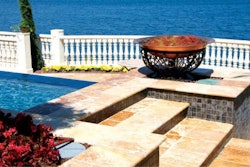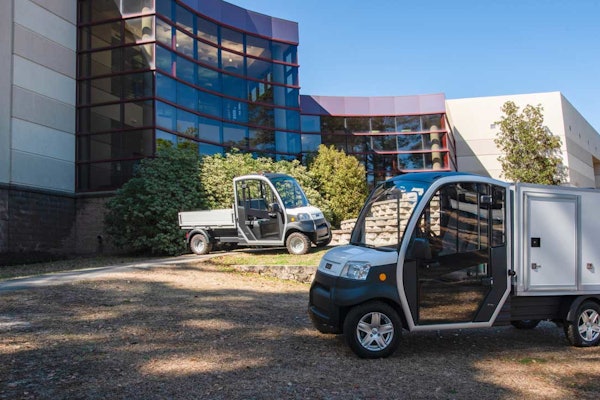Common-sense features adapt to changing needs
1. Seating located thoughout to offer respites 2. Stairs with 6” max risers and low-mounted lights 3. Obstacle-free paths slopes less than 1:12 gradient 4. Tactile warning strips at stair tops and handrails that extend a minimum of 1’ beyond top and bottom of stair 5. Multiple level permacultureOne of the most talked about demographic trends in America is the aging of the Baby Boom. If you are looking for the future of landscaping, you need look no further.
This huge chunk of our population will attempt to downsize their homes and properties and generally be faced with mobility and access issues that will present opportunities for savvy landscaping professionals.
“People want to stay in their homes and their gardens for life,” says Charles Schwab, AIA, of Schwab Architects in Rock Island, Illinois. “It’s not enough to improve access in and out of the house. Clients want to be involved in the landscape, perhaps on a smaller scale than before, but still involved.”
In recent polls of TLC readers and members of the American Society of Landscape Architects, more than a third of respondents stated there will be increased demand for residential landscape designs that allow owners to “age in place” and access their landscapes when confronted with limited mobility.
While you’re designing for today, recognize that circumstances and clients’ needs change.
You can enhance your projects and client loyalty by applying the concepts of universal design into your work now in anticipation of future needs.
The key principal of universal design is accessibility. It’s based on the idea that interior and exterior spaces should be designed to be usable by the greatest number of people, no matter what their abilities, for the longest time possible. Universal design was first seen in the United States with the need for barrier-free access in commercial settings. It has since evolved and is being incorporated into residential settings where it’s often referred to as “aging in place” design.
“For example, when you build a series of steps into a landscape, you’ve just made it difficult, if not impossible, for a certain segment of the population to use the space,” says Angela Dye, FASLA, of A Dye Design in Telluride, Colorado. “Universal design would employ a gentle slope instead of steps, and at the same time, create a more gracious entry.”
Making paths level is just as practical whether you’re a senior with mobility or vision issues, a parent pushing a stroller or a homeowner navigating the backyard with a wheelbarrow full of mulch. Universal design is a common-sense approach; it’s about making the space flexible so it can be adapted as the owner’s needs change.
Guiding principles
Whether you’re working on a new job, upgrading an old project or simply interested in creating more user-friendly landscapes, here are ways to introduce universal design into your projects:
1. Ease of Use
Physical access is only one facet of creating a landscape that’s easy to use. “Design can’t just focus on getting people in and out of a site,” says Shawn T. Kelly, FASLA, of Kelly Design Group in Williams Bay, Wisconsin. “The space must also be developed so it’s a place people will actually spend time in and enjoy without expending a great deal of physical effort.”
Scale down. If a client has a large property he or she can no longer manage because of time or physical constraints, “work on creating a little gem of a garden. You don’t have to develop the whole acre,” says Tim Gilbert, ASLA, principal, MIG, in Berkeley, California.
Select low-maintenance plantings. Dress up landscapes with woody plants and small shrubs instead of higher-maintenance annuals. Reduce watering needs with native plantings. Avoid prolific growers that require frequent trimming. Add perennials to the landscape over time to reduce cost impact.
Keep planting beds manageable. Reduce the width of borders to permit easier access. Cut beds no more than 4 feet wide if accessible from two sides, 2 feet wide if accessed from one side, Schwab says.
Offer a variety of seating areas. Place benches and seat walls throughout the landscape to encourage people to explore, rest and enjoy different views. Back support and armrests make it easier for seniors to rise. Provide shade to shelter seating.
Build in solutions for watering. Place water spigots at heights easily reached when standing or seated in a wheelchair. Use lever handles for faucets because they’re easier to nudge on or off if a client has diminished hand strength. If possible, space spigots throughout a garden to limit the distance water must be hauled.
2. Equitable Use
Whether public or private, a landscape should accommodate a wide range of individual interests, ages and ability levels. “You’re designing for everyone and every component,” says Keven Graham, ASLA, of Planning Resources in Wheaton, Illinois. “At the same time, the design is so subtle that it doesn’t appear any different from any other garden. It’s just inherently more appealing and functional.”
Provide alternative gardening experiences. In the Learning Garden at the Penn State University Cooperative Extension in Collegeville, Pennsylvania, different types of raised beds provide gardening options for a variety of ability levels. Vertical walls (planted on both sides), multi-tiered raised beds and 20-degree slanted raised beds accommodate both seated and standing gardeners.
Make paths easy to navigate. Keep paths firm, level or ramped with gentle slopes instead of steps in order to accommodate wheelchairs, scooters, walkers or those with low vision. When possible, maintain no more than a 1:20 gradient, Schwab says. Maintain widths of 48 inches with 5 feet for turn-around areas for wheelchairs.
Choose path materials carefully. There’s debate about what path surface is best because, for example, with smooth concrete, the joints can be a tripping hazard, aggregate can be too bumpy and wood can be slippery when wet. Crushed limestone, brick dust, smooth flagstone blocks and stabilized decomposed granite are possible alternatives.
Build in safety features. Think about potential hazards in a landscape. Avoid sharp corners on hardscape construction if designing spaces. Provide lighting along walkways or changes in elevation, and shield direct light sources to prevent blinding glare, which is especially important for seniors who have reduced night vision capabilities, Kelly says.
Accommodate users at every life stage by thinking about potential hazards in a landscape.
Frame a view. If clients are not mobile or if they spend a lot of time in a certain room indoors, think about how to capture the landscape and bring nature inside. Add window boxes, birdfeeders or an architectural showpiece to set off a landscape when viewed from inside the house.
3. Flexibility of Use
While designing for today, recognize that clients’ needs change. “No one has an idea what tomorrow will bring,” says Hunter Beckham, ASLA, principal with SWT Design in St. Louis, Missouri.
Engage the senses. Create a landscape that appeals to all of the senses, no matter a person’s abilities. Choose plants with varying textures. Add sound with fountains, birdbaths and wind chimes. Include fragrant plants, such as peonies and roses, and herbs, such as lemon verbena, mint and rosemary.
Incorporate edible landscaping. Return to the way our grandparents and great-grandparents gardened in their back yards: Mix edibles in with more traditional ornamentals in planting beds, containers, window boxes and raised beds.









